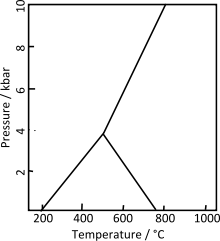Metamorphism
Metamorphism is the change of minerals or geologic texture (distinct arrangement of minerals) in pre-existing rocks (protoliths), without the protolith melting into liquid magma (a solid-state change).[1] The change occurs primarily due to heat, pressure, and the introduction of chemically active fluids. The chemical components and crystal structures of the minerals making up the rock may change even though the rock remains a solid. Changes at or just beneath Earth's surface due to weathering or diagenesis are not classified as metamorphism.[2] Metamorphism typically occurs between diagenesis (maximum 200°C), and melting (~850°C).[3]
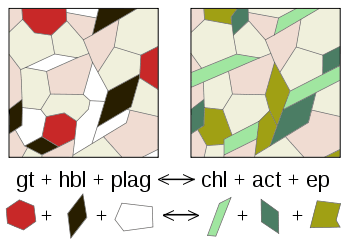
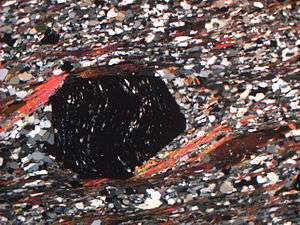
The geologists who study metamorphism are known as "metamorphic petrologists." To determine the processes underlying metamorphism, they rely heavily on statistical mechanics and experimental petrology.
Three types of metamorphism exist: contact, dynamic, and regional. Metamorphism produced with increasing pressure and temperature conditions is known as prograde metamorphism. Conversely, decreasing temperatures and pressure characterize retrograde metamorphism.
Solid state recrystallization and neocrystalization
Metamorphic rocks can change without melting. Heat causes atomic bonds to break, and the atoms move and form new bonds with other atoms, creating new minerals with different chemical components or crystalline structures (neocrystallization), or enabling recrystallization.[3] When pressure is applied, somewhat flattened grains that orient in the same direction have a more stable configuration.
Limits
The temperature lower limit on what is considered to be a metamorphic process is generally considered to be 100–200 °C;[4] this excludes diagenetic changes due to compaction and the formation of sedimentary rocks.
The upper boundary of metamorphic conditions is related to the onset of melting processes in the rock. The maximum temperature for metamorphism is typically 700–900 °C, depending on the pressure and on the composition of the rock. Migmatites are rocks formed at this upper limit, which contains pods and veins of material that has started to melt but has not fully segregated from the refractory residue. Since the 1980s it has been recognized that rocks are rarely dry enough and of a refractory enough composition to record without melting "ultra-high" metamorphic temperatures of 900–1100 °C. The metamorphic process usually occurs at pressures between 100 and 300 MPa, the depth at which these pressures occur depending on which type of rock is applying pressure.[5]
Types
Regional
Regional or Barrovian metamorphism covers large areas of continental crust typically associated with mountain ranges, particularly those associated with convergent tectonic plates or the roots of previously eroded mountains. Conditions producing widespread regionally metamorphosed rocks occur during an orogenic event. The collision of two continental plates or island arcs with continental plates produce the extreme compressional forces required for the metamorphic changes typical of regional metamorphism. These orogenic mountains are later eroded, exposing the intensely deformed rocks typical of their cores. The conditions within the subducting slab as it plunges toward the mantle in a subduction zone also produce regional metamorphic effects, characterized by paired metamorphic belts. The techniques of structural geology are used to unravel the collisional history and determine the forces involved. Regional metamorphism can be described and classified into metamorphic facies or metamorphic zones of temperature/pressure conditions throughout the orogenic terrane.
Contact (thermal)

Contact metamorphism occurs typically around intrusive igneous rocks as a result of the temperature increase caused by the intrusion of magma into cooler country rock. The area surrounding the intrusion where the contact metamorphism effects are present is called the metamorphic aureole.[6] Contact metamorphic rocks are usually known as hornfels. Rocks formed by contact metamorphism may not present signs of strong deformation and are often fine-grained.
Contact metamorphism is greater adjacent to the intrusion and dissipates with distance from the contact. The size of the aureole depends on the heat of the intrusion, its size, and the temperature difference with the wall rocks. Dikes generally have small aureoles with minimal metamorphism whereas large ultramafic intrusions can have significantly thick and well-developed contact metamorphism.
The metamorphic grade of an aureole is measured by the peak metamorphic mineral which forms in the aureole. This is usually related to the metamorphic temperatures of pelitic or aluminosilicate rocks and the minerals they form. The metamorphic grades of aureoles are andalusite hornfels, sillimanite hornfels, pyroxene hornfels.
Magmatic fluids coming from the intrusive rock may also take part in the metamorphic reactions. An extensive addition of magmatic fluids can significantly modify the chemistry of the affected rocks. In this case the metamorphism grades into metasomatism. If the intruded rock is rich in carbonate the result is a skarn. Fluorine-rich magmatic waters which leave a cooling granite may often form greisens within and adjacent to the contact of the granite. Metasomatic altered aureoles can localize the deposition of metallic ore minerals and thus are of economic interest.
A special type of contact metamorphism, associated with fossil fuel fires, is known as pyrometamorphism.[7][8]
Hydrothermal
Hydrothermal metamorphism is the result of the interaction of a rock with a high-temperature fluid of variable composition. The difference in composition between an existing rock and the invading fluid triggers a set of metamorphic and metasomatic reactions. The hydrothermal fluid may be magmatic (originate in an intruding magma), circulating groundwater, or ocean water. Convective circulation of hydrothermal fluids in the ocean floor basalts produces extensive hydrothermal metamorphism adjacent to spreading centers and other submarine volcanic areas. The fluids eventually escape through vents on the ocean floor known as black smokers.[9] The patterns of this hydrothermal alteration are used as a guide in the search for deposits of valuable metal ores.
Shock
Shock metamorphism occurs when an extraterrestrial object (a meteorite for instance) collides with the Earth's surface. Impact metamorphism is, therefore, characterized by ultrahigh pressure conditions and low temperature. The resulting minerals (such as SiO2 polymorphs coesite and stishovite) and textures are characteristic of these conditions.
Dynamic
Dynamic metamorphism is associated with zones of high to moderate strain such as fault zones. Cataclasis, crushing and grinding of rocks into angular fragments, occurs in dynamic metamorphic zones, giving cataclastic texture.
The textures of dynamic metamorphic zones are dependent on the depth at which they were formed, as the temperature and confining pressure determine the deformation mechanisms which predominate. Within depths less than 5 km, dynamic metamorphism is not often produced because the confining pressure is too low to produce frictional heat. Instead, a zone of breccia or cataclasite is formed, with the rock milled and broken into random fragments. This generally forms a mélange. At depth, the angular breccias transit into a ductile shear texture and into mylonite zones.
Within the depth range of 5–10 km, pseudotachylyte is formed because the confining pressure is enough to prevent brecciation and milling and thus energy is focused on discrete fault planes. Frictional heating, in this case, may melt the rock to form pseudotachylyte glass.
Within the depth range of 10–20 km, deformation is governed by ductile deformation conditions and hence frictional heating is dispersed throughout shear zones, resulting in a weaker thermal imprint and distributed deformation. Here, deformation forms mylonite, with dynamothermal metamorphism observed rarely as the growth of porphyroblasts in mylonite zones.
Overthrusting may juxtapose hot lower crustal rocks against cooler mid and upper crust blocks, resulting in conductive heat transfer and localised contact metamorphism of the cooler blocks adjacent to the hotter blocks, and often retrograde metamorphism in the hotter blocks. The metamorphic assemblages in this case are diagnostic of the depth and temperature and the throw of the fault and can also be dated to give an age of the thrusting.
Classification of metamorphic rocks
Metamorphic rocks are classified by their mineral composition, the source rock, also known as a protolith, and the context (pressure, temperature, hydrological features, etc.) of its formation.
Metamorphic facies
Metamorphic facies are recognizable terranes or zones with an assemblage of key minerals that were in equilibrium under specific range of temperature and pressure during a metamorphic event. The facies are named after the metamorphic rock formed under those facies conditions from basalt. Facies relationships were first described by Pentti Eskola in 1921.
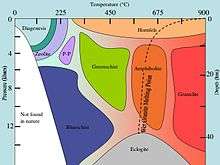
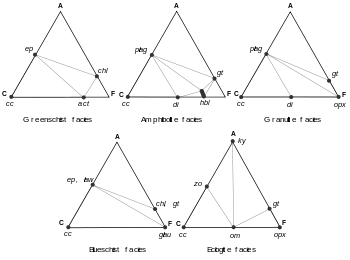
| Temperature | Pressure | Facies |
|---|---|---|
| Low | Low | Zeolite |
| Lower Moderate | Lower Moderate | Prehnite-Pumpellyite |
| Moderate to High | Low | Hornfels |
| Low to Moderate | Moderate to High | Blueschist |
| Moderate → High | Moderate | Greenschist→Amphibolite→Granulite |
| Moderate to High | High | Eclogite |
See diagram for more detail.
Metamorphic grades
Metamorphic grade is an informal indication of the amount or degree of metamorphism.[10] A more complete indication of this intensity or degree is provided with the concept of metamorphic facies.[10]
In the Barrovian sequence (described by George Barrow in zones of progressive metamorphism in Scotland), metamorphic grades are also classified by mineral assemblage based on the appearance of key minerals in rocks of pelitic (shaly, aluminous) origin:
Low grade ------------------- Intermediate --------------------- High grade
Metamorphic processes

Recrystallization
During recrystallization, the grains making up the protolith change shape and size. The identity of the mineral does not change during this process, only the texture. Recrystallization occurs due to heating of the protolith. The temperature at which this occurs can vary depending on the minerals present. Recrystallization generally begins when temperatures reach above half the melting point of the mineral on the Kelvin scale.[11]
Phase change
Phase change metamorphism is the creating of new minerals with the same chemical formula as the protolith. This involves a rearrangement of the atoms in the crystals.
Neocrystallization
Neocrystallization involves the creation of new mineral crystals different from the protolith. Chemical reactions digest the minerals of the protolith which yields new minerals. This is a very slow process as it can also involve the diffusion of atoms through solid crystals.
Pressure solution
Pressure solution is a metamorphic process that requires a rock to be under strong pressure from one direction and in the presence of hot water. During this process mineral of the protolith partially dissolve, diffuse through the water and precipitate elsewhere.
Prograde and retrograde
Metamorphism is further divided into prograde and retrograde metamorphism. Prograde metamorphism involves the change of mineral assemblages (paragenesis) with increasing temperature and (usually) pressure conditions. These are solid state dehydration reactions, and involve the loss of volatiles such as water or carbon dioxide. Prograde metamorphism results in rock characteristic of the maximum pressure and temperature experienced. Metamorphic rocks usually do not undergo further change when they are brought back to the surface.
Retrograde metamorphism involves the reconstitution of a rock via revolatisation under decreasing temperatures (and usually pressures), allowing the mineral assemblages formed in prograde metamorphism to revert to those more stable at less extreme conditions. This is a relatively uncommon process, because volatiles must be present.
Tectonic Settings
Commonly used diagrams
Petrogenetic grids
A petrogenetic grid is a geologic phase diagram that plots experimentally derived metamorphic reactions at their pressure and temperature conditions for a given rock composition. This allows geologists (specifically: metamorphic petrologists) to determine the pressure and temperature conditions under which rocks metamorphose. The Al2SiO5 nesosilicate phase diagram shown is a very simple petrogenetic grid for rocks that only have a composition consisting of aluminum (Al), silicon (Si), and oxygen (O). As the rock undergoes different temperatures and pressure, it could be any of the three given polymorphic minerals. For a rocks that contain more elements than that, the petrogenetic grid quickly becomes more complicated.
Compatibility diagrams
Compatibility diagrams provide an excellent way to analyze how variations in the rock's composition affect the mineral paragenesis that develops in a rock at particular pressure and temperature conditions.
See also
- Geothermobarometry – The science of measuring the pressure and temperature history of a metamorphic or intrusive igneous rocks
- Metamorphic rock – Rock that was subjected to heat and pressure
- Metasomatism – The chemical alteration of a rock by hydrothermal and other fluids
- Subduction zone metamorphism – Changes of rock due to pressure and heat near a subduction zone
- Ultra-high-temperature metamorphism – Crustal metamorphism with temperatures exceeding 900 °C
Footnotes
- Marshak, p 176
- Vernon, 2008, p. 1
- Marshak, p 177
- Bucher, p. 4.
- https://www.tulane.edu/~sanelson/eens212/typesmetamorph.htm
- Marshak, p. 187
- Grapes, R.H., 2006. Pyrometamorphism. Springer Verlag, Berlin
- Sokol, E.V., Maksimova, N.V., Nigmatulina, E.N., Sharygin, V.V., and Kalugin, V.M., 2005. Combustion metamorphism. Publishing House of the Siberian Branch of the Russian Academy of Sciences, Novosibirsk (in Russian, with parts in English)
- Marshak, p. 190.
- Marshak p. 183
- Gillen, p. 31
- Vernon, 1976, p. 149.
- Whitney, D.L. (2002). "Coexisting andalusite, kyanite, and sillimanite: Sequential formation of three Al2SiO5 polymorphs during progressive metamorphism near the triple point, Sivrihisar, Turkey". American Mineralogist. 87 (4): 405–416. Bibcode:2002AmMin..87..405W. doi:10.2138/am-2002-0404.
- Whitney, D.L. (2002). "Coexisting andalusite, kyanite, and sillimanite: Sequential formation of three Al2SiO5 polymorphs during progressive metamorphism near the triple point, Sivrihisar, Turkey". American Mineralogist. 87 (4): 405–416. Bibcode:2002AmMin..87..405W. doi:10.2138/am-2002-0404.
References
- Bucher, Kurt, 2002, Petrogenesis of Metamorphic Rock, Springer
- Eskola P., 1920, The Mineral Facies of Rocks, Norsk. Geol. Tidsskr., 6, 143–194
- Gillen, Cornelius, 1982, Metamorphic Geology : an Introduction to Tectonic and Metamorphic Processes, London; Boston: G. Allen & Unwin ISBN 978-0045510580
- Marshak, Stephen, 2009, Essentials of Geology, W. W. Norton & Company, 3rd ed. ISBN 978-0393196566
- Vernon, R. H., 1976, Metamorphic Processes, Halsted Press
- Vernon, Ronald Holden, 2008, Principles of Metamorphic Petrology, Cambridge University Press ISBN 978-0521871785
Further reading
- Winter J.D., 2001, An Introduction to Igneous and Metamorphic Petrology, Prentice-Hall ISBN 0-13-240342-0.
External links
- Recommendations by the IUGS Subcommission on the Systematics of Metamorphic Rocks, 1. How to Name a Metamorphic Rock
- Recommendations by the IUGS Subcommission on the Systematics of Metamorphic Rocks, 2. Types, Grade, and Facies of Metamorphism
- Recommendations by the IUGS Subcommission on the Systematics of Metamorphic Rocks, 3. Structural terms including fault rock terms
- Recommendations by the IUGS Subcommission on the Systematics of Metamorphic Rocks, 4. High P/T Metamorphic Rocks
- James Madison University: Metamorphism
- Barrovian Metamorphism: Brock Univ.
- Metamorphism of Carbonate Rocks: University of Wisconsin – Green Bay
- Metamorphic Petrology Database (MetPetDB) – Department of Earth and Environmental Sciences, Rensselaer Polytechnic Institute
